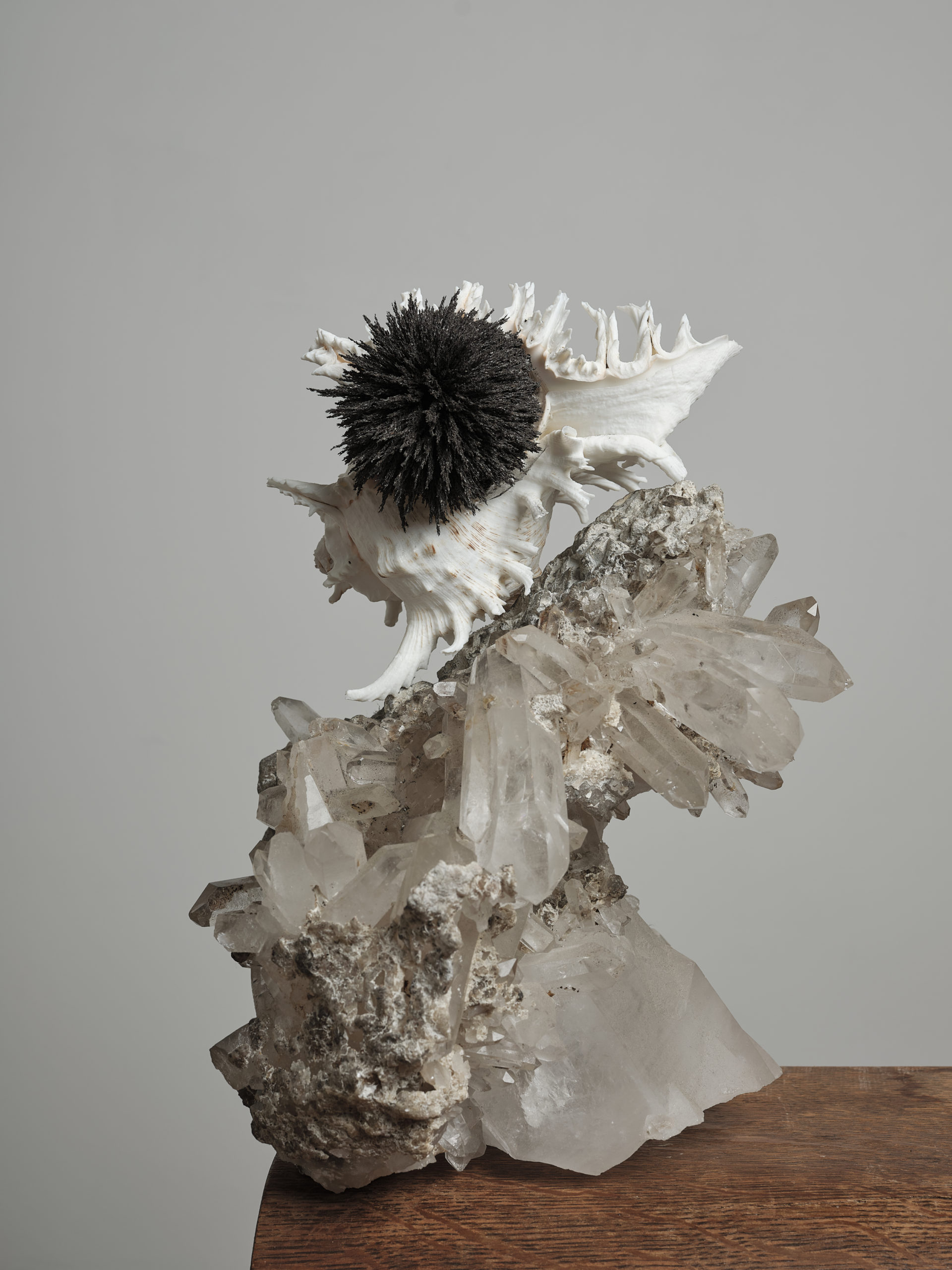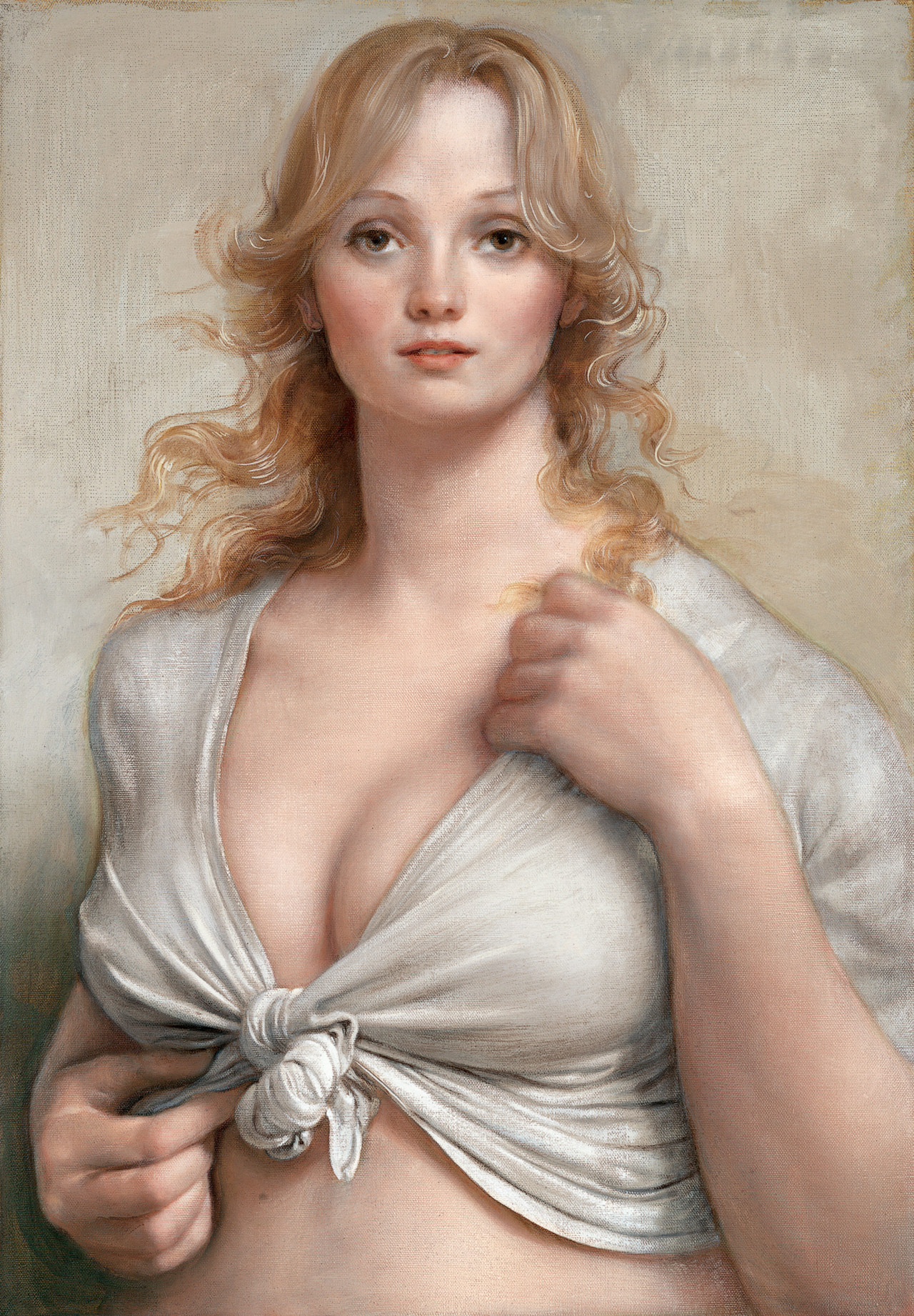Here, no. 11, 2022.
–
In peaceful Titirangi, Zac Langdon-Pole is enjoying his McCahon House residency. In the studio, he’s showing me a new sculpture he’s working on. A murex shell rests on a clump of quartz crystals. An arrangement of metallic-ore filings—reminding me of the form of a sea anemone—sprouts from the shell. Magically, the filings are organised and held in place by a hidden magnet. I can’t stop staring at this captivating arrangement. Small but sublime, it seems to contain the world.
‘It encompasses different materials, different states of being’, Langdon-Pole explains. ‘The quartz crystals are geological growth. The seashell—a spiral of calcite—was made by a living creature. The iron filings come from meteorites—they’re star dust. The components exemplify processes, organic and inorganic. It’s a very meditative piece.’
In the Langdon-Pole literature, there’s a lot of exegesis and explanation, a lot of citations and footnotes, but not much about meditation. There should be more. ‘I’m interested in prompting a certain quality and duration of attention. That’s really what I’m working with, more than any particular content or material’, the artist confesses, adding, ‘I like Italo Calvino’s motto: hurry slowly. Art needs to arrest your attention quickly, but sustain it indefinitely, slowly unfolding. It’s a fine balance.’
Langdon-Pole is thirty-three. After Elam, he studied at Frankfurt’s legendary Städelschule, a school that fostered two other New Zealand–expat success stories, Simon Denny and Luke Willis Thompson. He belongs to a generation of young artists who left New Zealand to do their post-grad study and were then on the spot to assimilate into the international art scene. Since Frankfurt, he’s been based in Berlin.
Winning a major art prize in 2018—the seventh BMW Art Journey Award at Art Basel—put Langdon-Pole on the fast track. He caught the judges’ eyes with his Passport (Argonauta) works. Carved meteorite fragments were fitted snugly into fragile octopus shells, perversely marrying animal and mineral, submarine and extraterrestrial. The works were beautifully resolved, yet their implications remained tantalisingly elusive. The Award enabled Langdon-Pole to conduct a grand global research trip, following the path of migratory birds as he explored the history of human celestial navigation and maps. It also enabled him to publish Constellations—a book on the trip and on his work to date.
At the end of 2019, after this globetrotting, Langdon-Pole returned home for a show with his Auckland dealer Michael Lett and a summer vacation with his family. That’s when I first met him. At that stage, I didn’t know so much about his work—I hadn’t yet seen a single piece in the flesh—but his reputation preceded him. I knew his work was erudite and omnivorous, traversing many knowledge systems—scientific, cultural, and historical—and taking diverse forms. Not one to accept press releases at face value, I was naturally sceptical, but also concerned that he might indeed be that smart. When Lett suggested I interview the artist before a live audience audience for the New Zealand launch of his book, I feared I was out of my depth, but I couldn’t say no. I spent the days before cramming.
With the talk, Langdon-Pole went easy on me. He was charming and convivial. A couple of weeks later, when I saw his Lett show, Interbeing (2020), everything clicked. The show encompassed massively enlarged photograms of sprinkled sand that suggested the vastness of outer space, hybrids of fossils and human anatomical models, and Assimilation Study, a wooden shape-block game where one piece had been replaced by a meteorite fragment tooled to the same shape. The simple but provocative way Langdon-Pole brought things together generated rippling associations and insights; every theory becoming a theory of relativity.
When Covid hit, not only was it hard for Langdon-Pole to return to Berlin, there wasn’t much to return for—his shows and residencies had been cancelled. He decided to stick it out in New Zealand. At the time I was Chief Curator at City Gallery Wellington and saw an opportunity. If he was going to be stranded here, perhaps he could make a big show for us. It became Containing Multitudes, which opened in November 2020.
Living and working in the sleepout at his parents’ place in Grey Lynn, Langdon-Pole came up with audacious ideas for new works for the show. He wanted to lay a whole gallery floor with borer-scarred native timber, where the borer tracks would be traced in gold leaf, recalling illuminated manuscripts and kintsugi ceramics. He wanted to make a film montaging clips from old New Zealand cel-animation films showing unpeopled natural landscapes. He did both.
But the works that surprised me most were his recombined-jigsaw-puzzle pictures. They emerged out of a simple observation. He recounts: ‘During lockdown, my nephew was doing a Where’s Wally jigsaw puzzle. There was another puzzle there, and I noticed that the pieces from both could be joined together, because of the common nature of the die cuts.’ Each of Langdon-Pole’s jigsaws combined pieces from two different puzzles, usually featuring encyclopaedia-plate and art-history imagery, with the artist suggestively fusing contradictory aesthetics and frames of reference. In one, the biblical Tower of Babel is replaced with a floral still life. In another, a bird in the hand is switched out with the night sky—the universe becoming bird shaped as part of the equation. Langdon-Pole’s jigsaws recall William Blake: seeing a world in a grain of sand and a heaven in a wild flower, and holding infinity in the palm of a hand.
The jigsaws look like surrealist collages, a bit Ernst, a bit Magritte. Like the surrealists, Langdon-Pole uses collage techniques to jolt us out of habitual ways of thinking and to access the marvellous. But, where surrealism engages the personal unconscious, Langdon-Pole goes further. He wants to lift us out of limited human-centred perspectives, into more-than-human ones, keyed to new ecological imperatives.
Langdon-Pole made twelve jigsaws for Containing Multitudes. He made seven more for Splendide Mendax, a dealer-gallery show at the Melbourne gallery Station in late 2021, a two-hander with Indigenous Australian painter Daniel Boyd, where there was an odd synergy between them and Boyd’s pixillated ‘dot’ paintings. There’s no doubting the jigsaws’ appeal. Langdon-Pole had found a way to make his complex ideas approachable, even quaint.
Reading is an important input. Langdon-Pole is a curious, roaming reader—a magpie. When we made Containing Multitudes, he had me reading Nell Irvin Painter’s The History of White People, David Abram’s The Spell of the Sensuous, and Maggie Nelson’s Bluets, while googling poet Walt Whitman and maverick biologist Lynn Margulis. Right now, his bedside reading is Cady Noland’s The Clip-On Method, Peter Zumthor’s Thinking Architecture, and Linda Rosenkrantz’s Peter Hujar’s Day. But, reading came late to him. ‘Early on, I was a slow reader and was nearly diagnosed with dyslexia. It wasn’t until I went to Frankfurt—which didn’t have a curriculum as such, and where research was almost entirely self directed—that I really started reading. For the first time in my life, I had the time. Reading is all about quality of attention. It’s not just what you read, but how you read. My work is about fostering that quality of attention.’
While Langdon-Pole’s work can seem impossibly broad, he does have some recurrent motifs, including birds and rocks. Birds imply the fleeting timeframe of flight (lightness) while rocks suggest the epic one of geomorphology (gravitas).
Langdon-Pole has made works about the myths surrounding birds of paradise and he favours bird imagery in his jigsaws. ‘Why birds?’, I ask. ‘For me, the bird thing started in Europe’ he says. ‘But, in New Zealand art, birds are everywhere. They are this postage-stamp idea of New Zealand. But few people are having a critical conversation about that. On the one hand, they are metaphors for human experience. On the other hand, they represent the other. They exist between worlds, between the ground and the air. They have a lot to teach us.’
And rocks? His answer is similar: ‘Geology is one of the most poetic sciences I know. The description of rocks relies entirely on poetry.’ But then, he comes back at it the other way, adding, ‘Emerson said “Language is fossil poetry.”’ So, a rock is a poem, a poem is a rock.
So much of Langdon-Pole’s work has been based on travel—passing through time and space. It’s been key to its production and reception. Does he miss frequent flying? What’s it like to be grounded? ‘I miss trains’, he says. ‘Living in Berlin, there’s a feeling that once a month you can step on a train and visit another city or another country. But, in Auckland, you can drive ten minutes and be at a beach, so I’m not complaining.’
But home life hasn’t been all beach towels and sun block. In January, Langdon-Pole had a nasty accident. ‘I rolled over in bed and suffered what they call a “bucket-handle meniscus tear”. My soft-tissue cartilage ripped in half and folded on top of itself and jammed in my knee. It was an ordeal. It was fourteen days in hospital unable to move, surgery, copious painkillers, and two months learning to walk again.’
This twist interests me, because so much of Langdon-Pole’s work is speculative, floating-on-clouds, out-of-body stuff—cultivating that more-than-human perspective. But what does it mean to be suddenly, rudely, disagreeably plunged back into your body through pain? Is your art thinking put on hold, or could experiencing an injury like this actually contribute to your work? When I asked him, he said: ‘Lately I’ve thought a lot about Julian Dashper’s Morphine Paintings. When Dashper was having cancer treatment, he made these beautiful blank canvases soaked in morphine. The morphine is, of course, invisible, so you have to be told. To me those works acknowledge the incommensurability of pain, yet still offer a sense of intimacy.’
Langdon-Pole is now back on his feet, easily traversing the split levels of the McCahon house studio. But he’s still doing his physio, riding his stationary bike every day. When I visit, he’s been there for six weeks, with six left, and he’s loving it. But I’m perplexed. Why do a residency in the city where you’re already living? His answer: ‘It’s great. You can be so productive. You maintain access to your familiar support structures to get things done, but you get space, time, and money. I’ve done residencies in the past that have been research opportunities, but I’ve come to this one already armed with ideas and I’m using it to make work.’ There is something idyllic about the McCahon House residence, deftly suspended in the bush. Langdon-Pole concurs: ‘It’s like a tree house. It’s a completely healing and serene place. There’s no better place to be.’


